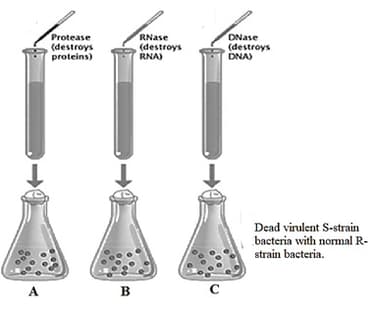Match column I with column II and select the CORRECT option.
Column I
Column II
Meselson and Stahl
Transduction
Jacob and Monod
X-ray diffraction data of DNA
Hershey and Chase
Semi-conservative DNA replication
Wilkins and Franklin
One gene one enzyme hypothesis
Beadle and Tatum
Operon system
Important Questions on Molecular Basis of Inheritance
| Column - I | Column - II | ||
| i | Griffith | p | Lac Operon |
| ii | Jacob and Monad | q | DNA is the genetic material |
| iii | Meselson and Stahl | r | Transforming principle |
| iv | Hershey and Chase | s | DNA replicates semi-conservatively |
Identify the labels marked A, B, C, D in a sequence in the illustrated diagram.

Secondary metabolites do not have identifiable physiological processes in plants, fungal and microbial cells
Bio macromolecules are acid insoluble organic compounds with mol wt more than daltons
Uridylic acid and cytidylic acids are derived from uracil and cytosine by esterification
Lecithin and lectin are phospholipids found in cell membrane
A student grew virus in three different media containing and DNAase separately and allow this virus to attack to E. coli. The series of observation made by the students are as follows:
a) labelled phage particles were produced in E. coli.
b) containing phage particles were produced E. coli.
c) Phage particles were observed in E. coli.
d) was not observed in phage particles produced by E. coli.
e) was not observed in phage particles produced by E. coli.
The correct observations are
A bacterial strain was heat killed. Another strain (living) was taken and mixed with this S strain. This mixture of strains were injected into mice. Which of the following are observed by Griffith?
I. The cells of strain were dead in dead mice.
II. The bacterial cells without polysaccharide coat are transformed into virulent strain in the injected mice.
II. Griffith could not find living strain in the body of dead mice.
IV. Griffith could find living strain in the body of dead mice.
The correct combination is:

DNA molecule has length of with guanosine. Choose the correct features of
Hydrogen bonds
Total nucleotides
Lederberg and Tatum found that the bacterium donates entire genetic material to recipient
Ehrenberg established link between bacteria and infectious diseases
Pasteur showed about the significant changes of nature brought by bacteria
Griffith discovered recipient cells of bacteria acquire previous characters
A) A nitrogen base is linked to the sugar through peptide linkage to form a nucleoside.
B) A polynucleotide chain has free phosphate moiety at end of sugar.
C) In RNA, nucleotide residue has an additional - group at the position of the ribose sugar.
D) It is observed that in DNA, the A: T ratio and C: G ratio are not constant all the time.

